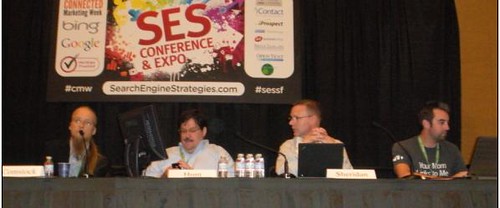
Thanks to Ray ‘Catfish’ Comstock for providing the title of this post with his opening remarks during the session. Joining Comstock on this panel, moderated by Seth Besmertnik, CEO, Conductor, Inc.:
- Crispin Sheridan, SES Advisory Board & Sr Director of Search Marketing Strategy, SAP
- Bill Hunt, SES Advisory Board & President, Back Azimuth Consulting
- Guillaume Bouchard, Co-founder and CEO, NVI
As a good writer and analyst, I have to ask ‘why’ for even the most obvious problem posed. So why is enterprise level Search Engine Optimization (SEO) not for the weak? The obvious answer: a lot of people, a lot of content. Enterprise is difficult because management of a lot of content and people is difficult to scale.
A recurring theme at the SES sessions I’ve attended this year is the importance of communicating SEO in a language that non-search professionals (high level executives) will understand. TopRank CEO Lee Odden even offered the presentation ‘Selling Search to the C-Suite.’
Let’s identify the problems a C-level executive may have with a fairly basic statement that illustrates the positive results of an SEO campaign:
“Our SEO efforts have helped decrease bounce rate 40% over the last 90 day from visits generated by organic keywords.”
- What is bounce rate?
- What do you mean by ‘organic’ keywords?
- Why are you not talking about revenue?
Let’s say the same thing a little bit differently:
“SEO recommendations made to our small business software page have helped decrease the amount of traffic that immediately abandons this page by 40%. As bounce rate has decreased, the amount of visitors who have converted to sales has increased 75%.”
A great line from the movie Adaptation (which I am probably getting wrong) is ‘Get them in the third act. No matter what else is wrong with your story, you’ll win if you can get them in the third act.’
Communicating a direct effect on revenue is a great capper for any communication with a C-level and a great way to get buy-in for other SEO tactics you KNOW you need to implement. For example:
- Cleaning up duplicate content
The more duplicate content we have, the fewer results search engines will show from our site. Fewer webpages basically means we have fewer salespeople online. - Creating content
There is a huge gap in content for this topic between our site and our competitor’s site. Here is a graph showing all our potential customers that are going to our competitor’s website.
- Internal linking
Every link we add to our pages is like a ‘vote’ for this content to search engines. Every vote ranks us higher and puts us in front of more customers.
You may notice that many of the tactics described above match recommendation shared in previous posts. Ultimately, SEO best practices are SEO best practices. All enterprise adds is the need for prioritization and the need for buy-in.
And the path to both is the path to revenue.


